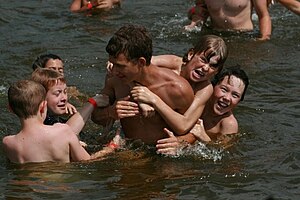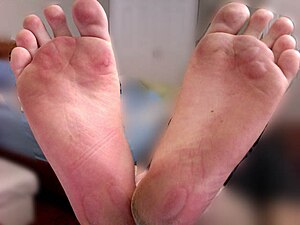 Kids playing in a lake at a church camp (Photo credit: Wikipedia)Hope you all caught Part I, and if you’re back for Part II, let’s take a moment and thank you for making a sound and important decision in the development and well-being of your children. Their futures are very much in your hands and they need strong and steady guidance. What better way than to lead by example.
Kids playing in a lake at a church camp (Photo credit: Wikipedia)Hope you all caught Part I, and if you’re back for Part II, let’s take a moment and thank you for making a sound and important decision in the development and well-being of your children. Their futures are very much in your hands and they need strong and steady guidance. What better way than to lead by example.So you’ve made the decision to kick it in gear and you want to take off on a little run. Let’s make sure you have the things you might need. These items can fit in a child’s back pack, and yes, the child can carry it.
• Small first aid kit (be prepared)
• Cell phone
• Bottled water (everyone carries their own) or have a route planned where you know water is available
• Submit a plan by letting someone know where you are going and when you will be returning
Check everyone’s shoes. Make sure there is adequate arch support and cushioning and the fit is appropriate. These are two things that can lead to foot and ankle pain and now that you are in motion, you don’t want to slow down. You have your destination in mind now, but one more important preliminary:
Never start out running without first doing some warm up activities like stretching. You just can’t take the muscles from cold to hot without first advising the muscles what to expect. That’s what the warm up is all about. Allow yourselves a good five minutes to stretch and warm up by doing the following:
• Start with feet and point toes/point heels
• Rotate ankles both directions
• Stretch out legs
• Flex calf muscles
• Stretch out upper leg muscles
• Gently twist torso side to side
• Bend over and touch toes (do not bounce)
• A few arm rotations in small circles and giant circles
• Head circles and side to sides
On your mark, get set, go! But not too fast, remember, you are working into this slowly. When you’re done running, stretch again to cool down and walk it off. Now wasn’t that exhilarating?
Dr. Teichman has expert advice for you about your feet and ankles. You can have healthy feet for the rest of your life. If you have any unexplained foot or ankle pain, call (610)432-9593, or visit us at http://eastpennfoot.com/. See you on the jog path!








